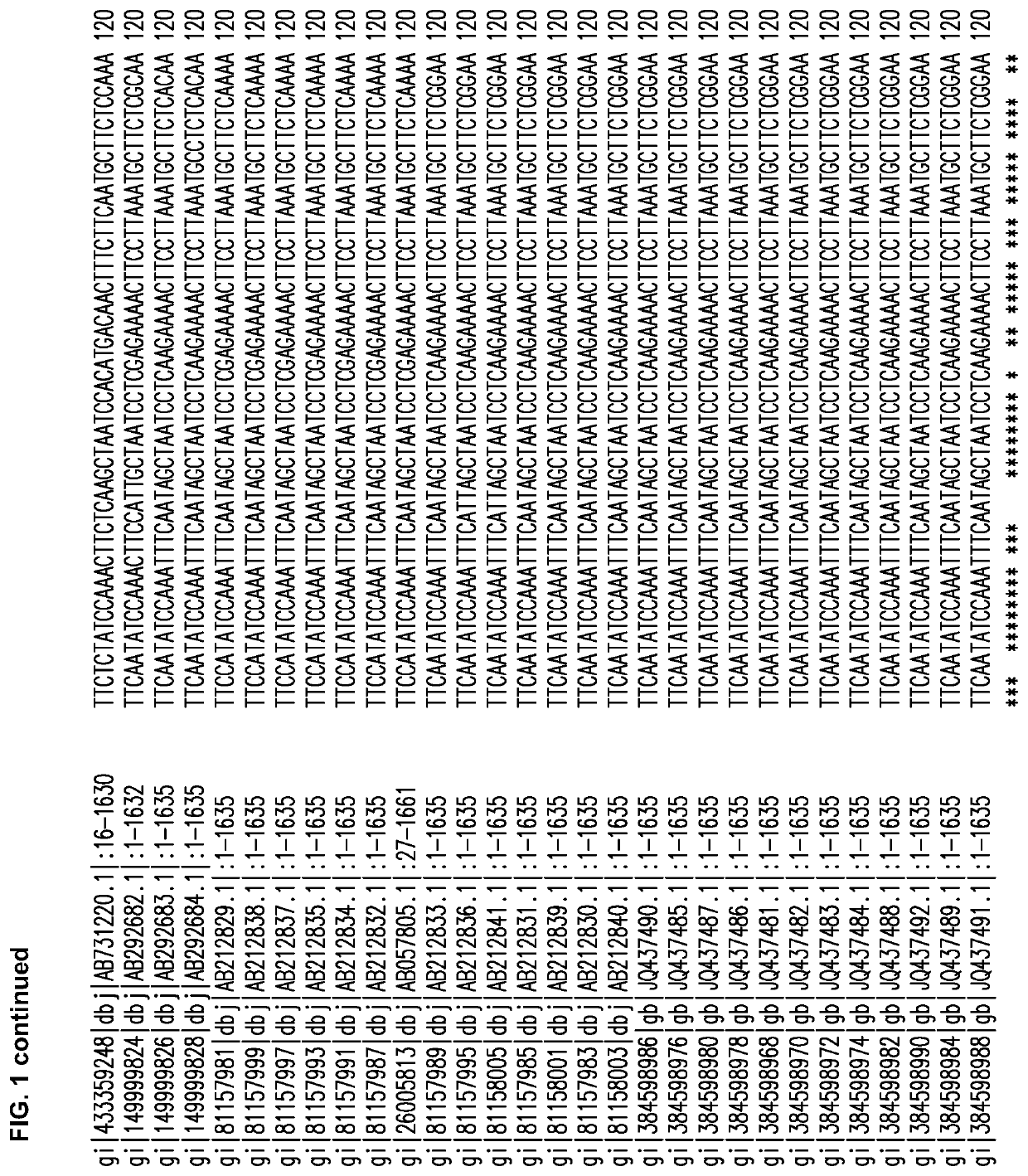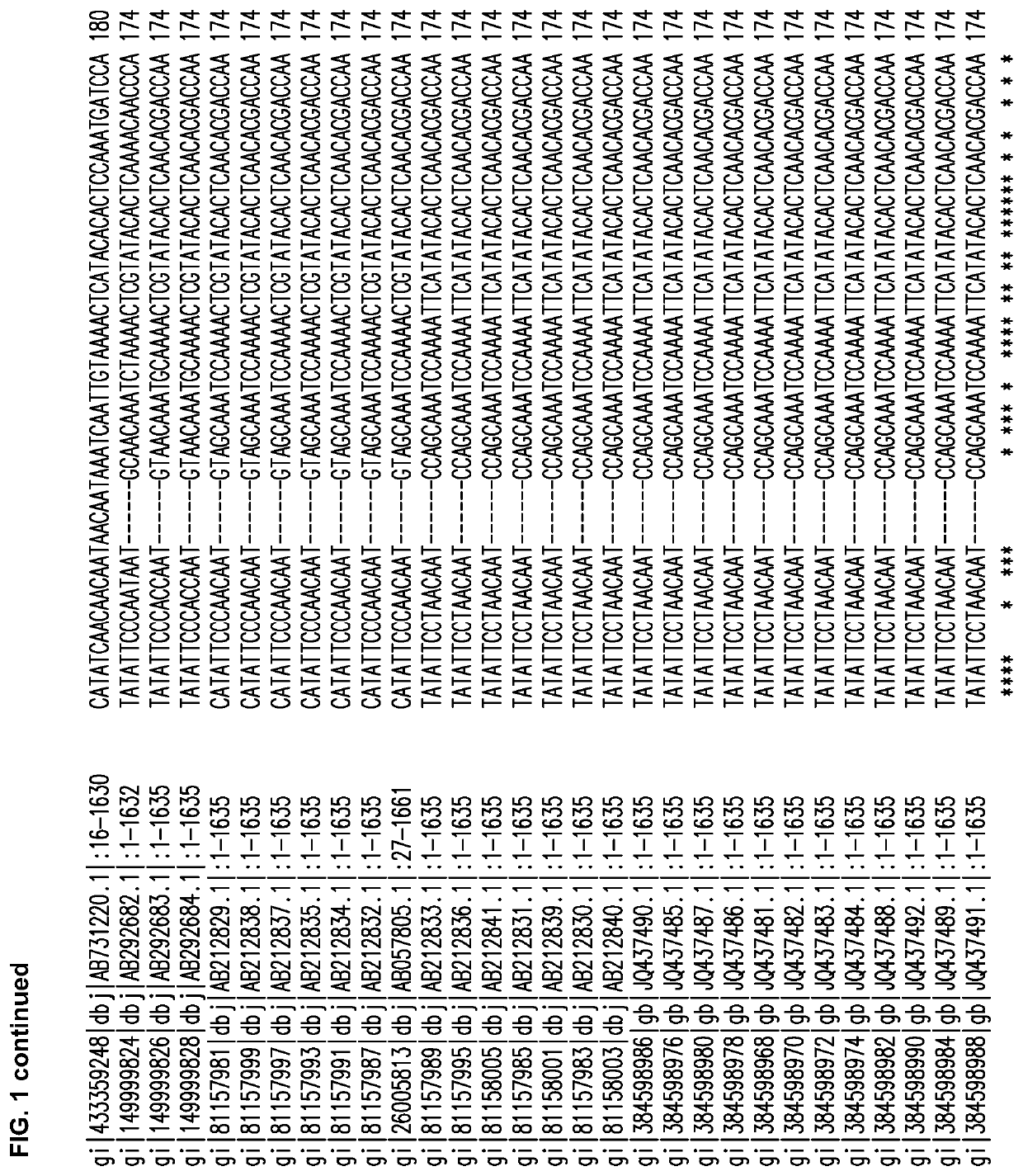Cannabis plants having modified expression of THCA synthase
a technology of thca synthase and cannabis, which is applied in the direction of angiosperm/flowering plants, plant ingredients, enzymes, etc., can solve the problems of affecting the efficacy of the therapy, affecting the effect of the therapy, and variable drowsiness and sedation, so as to reduce the delta-9-tetrahydrocannabinol (thc) and increase the content of cannabidiol (cbd)
- Summary
- Abstract
- Description
- Claims
- Application Information
AI Technical Summary
Benefits of technology
Problems solved by technology
Method used
Image
Examples
example 1
THCA Synthase Cloning and Sequencing
[0308]Several Cannabis sativa THCA synthase sequences were aligned, and FIG. 1 shows the alignment obtained using the CLUSTAL O (1.2.1) multiple sequence alignment program available at world wide web.ebi.ac.uk / Tools / msa / clustalw2.
[0309]Alignments of 30 THCA synthase gene accessions in GenBank have identified highly conserved sequence regions (13 regions of 21 to 42 bp) from which PCR primers can be generated for DNA amplification followed by cloning into intermediate vectors. To reduce errors introduced by PCR, an editing enzyme can be used and multiple independent amplifications can provide DNA for sequencing; thus, allowing the removal of rare mutations that may arise from the process of amplification. In certain embodiments, the THCA synthase gene sequence of cannabis strains used by TWEED® can be used to ensure functionality of antisense RNA (asRNA).
[0310]The THCA synthase coding genes from 3 Cannabis sativa strains (DK-1, ND-1 and SH-4) were ...
example 2
Design of RNA Interfering Constructs
[0312]In order to avoid off-target effects by silencing unrelated genes / proteins, conserved domains were avoided when designing RNA interference constructs. Conserved protein domains were identified in the THCA synthase by searching for conserved domains in the National Center for Biotechnology Information (NCBI) database. FIG. 5 depicts the protein domains berberine and berberine-like (BBE) domains and FAD-binding domain located in the region of amino acid interval 480-538 and amino acid interval 81-218, respectively of the THCA synthase. FAD-binding domains are present in various enzymes that bind FAD as cofactor. BBE domains are found in multiple enzymes that are involved in the biosynthesis of various isoquinoline alkaloids. A GlcD domain, located in the region of amino acid interval 81-540 and depicted in FIG. 5, was also identified. This domain is a Glycolate oxidase subunit GlcD domain that is characteristic for prokaryotic enzymes and was ...
example 3
Design of Antisense Constructs
[0313]For creating an expression cassette encoding RNAi constructs to induce RNA silencing via double-stranded RNA formation, full antisense RNA encoding DNA (SEQ ID NO:81) was amplified by PCR. The primers used for PCR were THCA-FullAS-F (SEQ ID NO:59) and THCA-FullAS-R (SEQ ID NO:60). The PCR fragment was cloned into pGEM vector and the sequence was verified.
[0314]In order to create a base vector suitable for transgenic expression of antisense RNA or interfering RNA, a promoter and a suitable multiple cloning site was inserted into vector pCAMBIA1391 to create the pCAMBIA1391-35S vector, depicted in FIG. 6. The 35S promoter (CaMV35S) is a Cauliflower mosaic virus promoter and can be used as universal promoter for constitutive antisense expression in Cannabis sativa and is also useful in RNA interference constructs. Alternatively, the tCUP promoter (tomato cryptic promoter) can also be used for high constitutive expression in Cannabis sativa.
[0315]The...
PUM
| Property | Measurement | Unit |
|---|---|---|
| length | aaaaa | aaaaa |
| size | aaaaa | aaaaa |
| concentration | aaaaa | aaaaa |
Abstract
Description
Claims
Application Information
 Login to View More
Login to View More - R&D
- Intellectual Property
- Life Sciences
- Materials
- Tech Scout
- Unparalleled Data Quality
- Higher Quality Content
- 60% Fewer Hallucinations
Browse by: Latest US Patents, China's latest patents, Technical Efficacy Thesaurus, Application Domain, Technology Topic, Popular Technical Reports.
© 2025 PatSnap. All rights reserved.Legal|Privacy policy|Modern Slavery Act Transparency Statement|Sitemap|About US| Contact US: help@patsnap.com



